Development of a Calculation Concept for Mapping Specific Heat Extraction for Very Shallow Geothermal Systems
Abstract
:1. Introduction
2. Research Methodology
2.1. Data Sources
2.2. Adaption Process
2.2.1. STEP 1—Definition of HDD
- HDD22/14 represents the heating degree days according to ÖNORM B 8110-5;
- Tin is the average inside temperature, which is defined as 22 °C;
- Tout is the average outside temperature of the respective month (in °C); and
- d is the number of days in the respective month when ambient T < 14 °C.
2.2.2. STEP 2—Correlation of Heat Extraction Rate with HDD (Area of Derivation)
2.2.3. STEP 3—Correlation of HDD with altitude (Area of Application)
2.2.4. STEP 4—Transfer of Heat Extraction to Area of Application
2.2.5. STEP 5—Consideration of Soil Map Information
3. Results
4. Discussion
5. Conclusions
References
Author Contributions
Funding
Institutional Review Board Statement
Informed Consent Statement
Data Availability Statement
Acknowledgments
Conflicts of Interest
Appendix A
| NR. | Locality | Altitude (Average of DIN 4710-Stated Values) (m ASL) | Respective Climate Zone |
|---|---|---|---|
| 1 | Bremerhaven/Norderney | 18 | (1) Bremerhaven |
| 2 | Rostock-Warnemünde/Heiligendamm | 13 | (2) Rostock-Warnemünde |
| 3 | Hamburg-Fuhlsbüttel/Hamburg-Sasel | 31 | (3) Hamburg-Fuhlsbüttel |
| 4 | Potsdam | 81 | (4) Potsdam |
| 5 | Essen/Gelsenkirchen/Bochum | 134 | (5) Essen |
| 6 | Bad Marienberg/Bad Lippspringe | 355 | (6) Bad Marienberg |
| 7 | Kassel | 231 | (7) Kassel |
| 8 | Braunlage | 607 | (8) Braunlage |
| 9 | Chemnitz | 418 | (9) Chemnitz |
| 10 | Hof/Zinnwald | 722 | (10) Hof |
| 11 | Fichtelberg | 1213 | (11) Fichtelberg |
| 12 | Mannheim | 96 | (12) Mannheim |
| 13 | Passau | 409 | (13) Passau |
| 14 | Stötten/Stuttgart-Schnarrenberg | 526 | (14) Stötten |
| 15 | Garmisch-Partenkirchen | 596 | (15) Garmisch-Partenkirchen |
| NR. | Locality | Altitude (m ASL) |
|---|---|---|
| 1 | Bad Gleichenberg | 282 |
| 2 | Bregenz | 424 |
| 3 | Eisenstadt | 184 |
| 4 | Feuerkogel | 1618 |
| 5 | Graz-Uni | 366 |
| 6 | Hohenau/March | 155 |
| 7 | Innsbruck-Uni | 581 |
| 8 | Irdning-Gumpenstein | 707 |
| 9 | Klagenfurt | 448 |
| 10 | Kresmünste | 383 |
| 11 | Kufstein | 495 |
| 12 | Langen am Arlberg | 1250 |
| 13 | Lienz | 659 |
| 14 | Linz-Stadt | 263 |
| 15 | Loibl-Tunnel | 1092 |
| 16 | Obergurgl | 1938 |
| 17 | Patscherkofel | 2247 |
| 18 | Reutte | 852 |
| 19 | Ried im Innkreis | 435 |
| 20 | Salzburg-Flughafen | 430 |
| 21 | Schöckl | 1436 |
| 22 | Sonnblick | 3105 |
| 23 | St. Pölten | 260 |
| 24 | St. Sebastian-Mariazell | 872 |
| 25 | Tamsweg | 1024 |
| 26 | Villacher Alpe | 2160 |
| 27 | Wien-Hohe Warte | 200 |
| 28 | Zell am See | 766 |
| 29 | Zeltweg | 677 |
| 30 | Zwettl-Stift | 506 |
| Major Soil Texture Groups Applied in VDI 4640 Part 2 | Soil Types of the Austrian Soil Classification | Silt% | Clay% | Sand% |
|---|---|---|---|---|
| Sand | Sand (S) | 15 | 5 | 80 |
| Sand | Silty Sand (uS) | 42.5 | 2.5 | 55 |
| Loam | Loamy Sand (lS) | 37.5 | 10 | 52.5 |
| Silt | Sandy Silt (sU) | 65 | 10 | 25 |
| Silt | Silt (U) | 85 | 10 | 5 |
| Loam | Clayey Sand (tS) | 5 | 17.5 | 77.5 |
| Loam | Sandy Loam (sL) | 37.5 | 20 | 42.5 |
| Silt | Loamy Silt (lU) | 65 | 20 | 15 |
| Loam | Sandy Clay (sT) | 5 | 32.5 | 62.5 |
| Loam | Loam (L) | 37.5 | 32.5 | 30 |
| Silt | Silty Loam (uL) | 65 | 30 | 5 |
| Silt | Loamy Clay (lT) | 27.5 | 45 | 27.5 |
| Silt | Clay (T) | 25 | 75 | 0 |
References
- European Commission 2015–2021: Heating and Cooling. Available online: https://ec.europa.eu/energy/topics/energy-efficiency/heating-and-cooling_en (accessed on 5 January 2022).
- Haehnlein, S.; Bayer, P.; Blum, P. International legal status of the use of shallow geothermal energy. Renew. Sust. Energ. Rev. 2010, 14, 2611–2625. [Google Scholar] [CrossRef]
- Goldbrunner, J. Oberflächennahe Geothermie in Österreich. In Handbuch Oberflächennahe Geothermie, 1st ed.; Bauer, M., Freeden, W., Jacobi, H., Neu, T., Eds.; Springer: Berlin/Heidelberg, Germany, 2018; pp. 739–753. [Google Scholar]
- Bertermann, D.; Klug, H.; Morper-Busch, L.; Bialas, C. Modelling vSGPs (very shallow geothermal potentials) in selected CSAs (case study areas). Energy 2014, 71, 226–244. [Google Scholar] [CrossRef]
- Jocić, N.; Müller, J.; Požar, T.; Bertermann, D. Renewable Energy Sources in a Post-Socialist Transitional Environment: The Influence of Social Geographic Factors on Potential Utilization of Very Shallow Geothermal Energy within Heating Systems in Small Serbian Town of Ub. Appl. Sci. 2020, 10, 2739. [Google Scholar] [CrossRef] [Green Version]
- Zeh, R.; Ohlsen, B.; Philipp, D.; Bertermann, D.; Kotz, T.; Jocić, N.; Stockinger, V. Large-Scale Geothermal Collector Systems for 5th Generation District Heating and Cooling Networks. Sustainability 2021, 13, 6035. [Google Scholar] [CrossRef]
- Ochsner, T.E.; Horton, R.; Ren, T. A new perspective on soil thermal properties. Soil Sci. Soc. Am. J. 2001, 65, 1641–1647. [Google Scholar] [CrossRef]
- Abu-Hamdeh, N.H. Thermal properties of soils as affected by density and water content. Biosyst. Eng. 2003, 86, 97–102. [Google Scholar] [CrossRef]
- Schwarz, H.; Bertermann, D. Mediate relation between electrical and thermal conductivity of soil. Geomech. Geophys. Geo-Energy Geo-Resour. 2020, 6, 50. [Google Scholar] [CrossRef]
- Côté, J.; Konrad, J.M. A generalized thermal conductivity model. Can. Geotech. J. 2005, 42, 443–458. [Google Scholar] [CrossRef]
- Barry-Macaulay, D.; Bouazza, A.; Singh, R.M.; Wang, B.; Ranjith, P.G. Thermal conductivity of soils and rocks from the Melbourne (Australia) region. Eng. Geol. 2013, 164, 131–138. [Google Scholar] [CrossRef] [Green Version]
- Lu, Y.; Lu, S.; Horton, R.; Ren, T. An empirical model for estimating soil thermal conductivity from texture, water content, and bulk density. Soil Sci. Soc. Am. J. 2014, 78, 1859–1868. [Google Scholar] [CrossRef]
- Bertermann, D.; Schwarz, H. Laboratory device to analyse the impact of soil properties on electrical and thermal conductivity. Int. Agrophys. 2017, 31, 157. [Google Scholar] [CrossRef] [Green Version]
- Lu, S.; Lu, Y.; Peng, W.; Ju, Z.; Ren, T. A generalized relationship between thermal conductivity and matric suction of soils. Geoderma 2019, 337, 491–497. [Google Scholar] [CrossRef]
- Bertermann, D.; Müller, J.; Freitag, S.; Schwarz, H. Comparison between measured and calculated thermal conductivities within different grain size classes and their related depth ranges. Soil Syst. 2018, 2, 50. [Google Scholar] [CrossRef] [Green Version]
- Bertermann, D.; Klug, H.; Morper-Busch, L. A pan-European planning basis for estimating the very shallow geothermal energy potentials. Renew. Energ. 2015, 75, 335–347. [Google Scholar] [CrossRef]
- Di Sipio, E.; Bertermann, D. Factors influencing the thermal efficiency of horizontal ground heat exchangers. Energies 2017, 10, 1897. [Google Scholar] [CrossRef] [Green Version]
- Abu-Hamdeh, N.H.; Reeder, R.C. Soil thermal conductivity effects of density, moisture, salt concentration, and organic matter. Soil Sci. Soc. Am. J. 2000, 64, 1285–1290. [Google Scholar] [CrossRef]
- Zhu, D.; Ciais, P.; Krinner, G.; Maignan, F.; Puig, A.J.; Hugelius, G. Controls of soil organic matter on soil thermal dynamics in the northern high latitudes. Nat. Commun. 2019, 10, 3172. [Google Scholar] [CrossRef] [Green Version]
- Martinopoulos, G.; Papakostas, K.T.; Papadopoulos, A.M. A comparative review of heating systems in EU countries, based on efficiency and fuel cost. Renew. Sust. Energ. Rev. 2018, 90, 687–699. [Google Scholar] [CrossRef]
- Pu, L.; Xu, L.; Qi, D.; Li, Y. Structure optimization for horizontal ground heat exchanger. Appl. Therm. Eng. 2018, 136, 131–140. [Google Scholar] [CrossRef]
- Yan, T.; Xu, X. Utilization of Ground Heat Exchangers: A Review. Curr. Sustain. Renew. Energy Rep. 2018, 5, 189–198. [Google Scholar] [CrossRef]
- Boban, L.; Miše, D.; Herceg, S.; Soldo, V. Application and Design Aspects of Ground Heat Exchangers. Energies 2021, 14, 2134. [Google Scholar] [CrossRef]
- Müller, J.; Galgaro, A.; Dalla Santa, G.; Cultrera, M.; Karytsas, C.; Mendrinos, D.; Pera, S.; Perego, R.; O’Neill, N.; Pasquali, R.; et al. Generalized pan-European geological database for shallow geothermal installations. Geosci. J. 2018, 8, 32. [Google Scholar] [CrossRef] [Green Version]
- Ramos-Escudero, A.; García-Cascales, M.S.; Cuevas, J.M.; Sanner, B.; Urchueguía, J.F. Spatial analysis of indicators affecting the exploitation of shallow geothermal energy at European scale. Renew. Energ. 2021, 167, 266–281. [Google Scholar] [CrossRef]
- Assouline, D.; Mohajeri, N.; Gudmundsson, A.; Scartezzini, J.L. A machine learning approach for mapping the very shallow theoretical geothermal potential. Geotherm. Energy 2019, 7, 19. [Google Scholar] [CrossRef] [Green Version]
- VDI. VDI 4640-2—Technical Rule 4640-2, Thermal Use of the Underground, Ground Source Heat Pump Systems; VDI, Beuth Publishing House: Berlin, Germany, 2019. [Google Scholar]
- DIN. DIN 4710, Statistics on German Meteorological Data for Calculating the Energy Requirements for Heating and Air Conditioning Equipment; DIN, Beuth Publishing House: Berlin, Germany, 2003. [Google Scholar]
- Ramming, K. Bewertung und Optimierung Oberflächennaher Erdwärmekollektoren für Verschiedene Lastfälle. Ph.D. Thesis, Technische Universität Dresden, Dresden, Germany, 26 April 2007. [Google Scholar]
- Digitales Geländemodell von Österreich, Version 50 Meter. Available online: http://data.opendataportal.at/dataset/dgm-austria (accessed on 20 November 2020).
- Digitale Bodenkarte Österreich, eBod. Available online: https://bodenkarte.at/#/center/ (accessed on 20 November 2020).
- Zentralanstalt für Meteorologie und Geodynamik—(ZAMG). Klimamonitoring. Available online: https://www.zamg.ac.at/cms/de/klima/klima-aktuell/klimamonitoring/?station=19204¶m=t&period=period-ym-2020-01&ref=3 (accessed on 21 December 2020).
- Spinoni, J.; Vogt, J.; Barbosa, P. European degree-day climatologies and trends for the period 1951–2011. Int. J. Climatol. 2015, 35, 25–36. [Google Scholar] [CrossRef] [Green Version]
- Austrian Standards International. ÖNORM B 8110-5; Thermal Insulation in Building Construction—Part 5: Model of Climate and User Profiles. Austrian Standards International: Vienna, Austria, 2019.
- Castañeda, M.E.; Claus, F. Variability and trends of heating degree-days in Argentina. Int. J. Climatol. 2013, 33, 2352–2361. [Google Scholar] [CrossRef]
- Janković, A.; Podraščanin, Z.; Djurdjevic, V. Future climate change impacts on residential heating and cooling degree days in Serbia. Időjárás—Q. J. Hung. Meteorol. Serv. (OMSZ) 2019, 123, 351–370. [Google Scholar] [CrossRef] [Green Version]
- Ramon, D.; Allacker, K.; De Troyer, F.; Wouters, H.; van Lipzig, N.P. Future heating and cooling degree days for Belgium under a high-end climate change scenario. Energy Build. 2020, 216, 109935. [Google Scholar] [CrossRef]
- Atalla, T.; Gualdi, S.; Lanza, A. A global degree days database for energy-related applications. Energy 2018, 143, 1048–1055. [Google Scholar] [CrossRef] [Green Version]
- Roshan, G.R.; Ghanghermeh, A.A.; Attia, S. Determining new threshold temperatures for cooling and heating degree day index of different climatic zones of Iran. Renew. Energ. 2017, 101, 156–167. [Google Scholar] [CrossRef] [Green Version]
- Christenson, M.; Manz, H.; Gyalistras, D. Climate warming impact on degree-days and building energy demand in Switzerland. Energy Convers. Manag. 2006, 47, 671–686. [Google Scholar] [CrossRef]
- Busby, J.; Lewis, M.; Reeves, H.; Lawley, R. Initial geological considerations before installing ground source heat pump systems. Q. J. Eng. Geol. Hydrogeol. 2009, 42, 295–306. [Google Scholar] [CrossRef]
- Roshankhah, S.; Garcia, A.V.; Carlos Santamarina, J. Thermal Conductivity of Sand–Silt Mixtures. J. Geotech. Geoenviron. Eng. 2021, 147, 06020031. [Google Scholar] [CrossRef]
- Markert, A.; Bohne, K.; Facklam, M.; Wessolek, G. Pedotransfer functions of soil thermal conductivity for the textural classes sand, silt, and loam. Soil Sci. Soc. Am. J. 2017, 81, 1315–1327. [Google Scholar] [CrossRef]

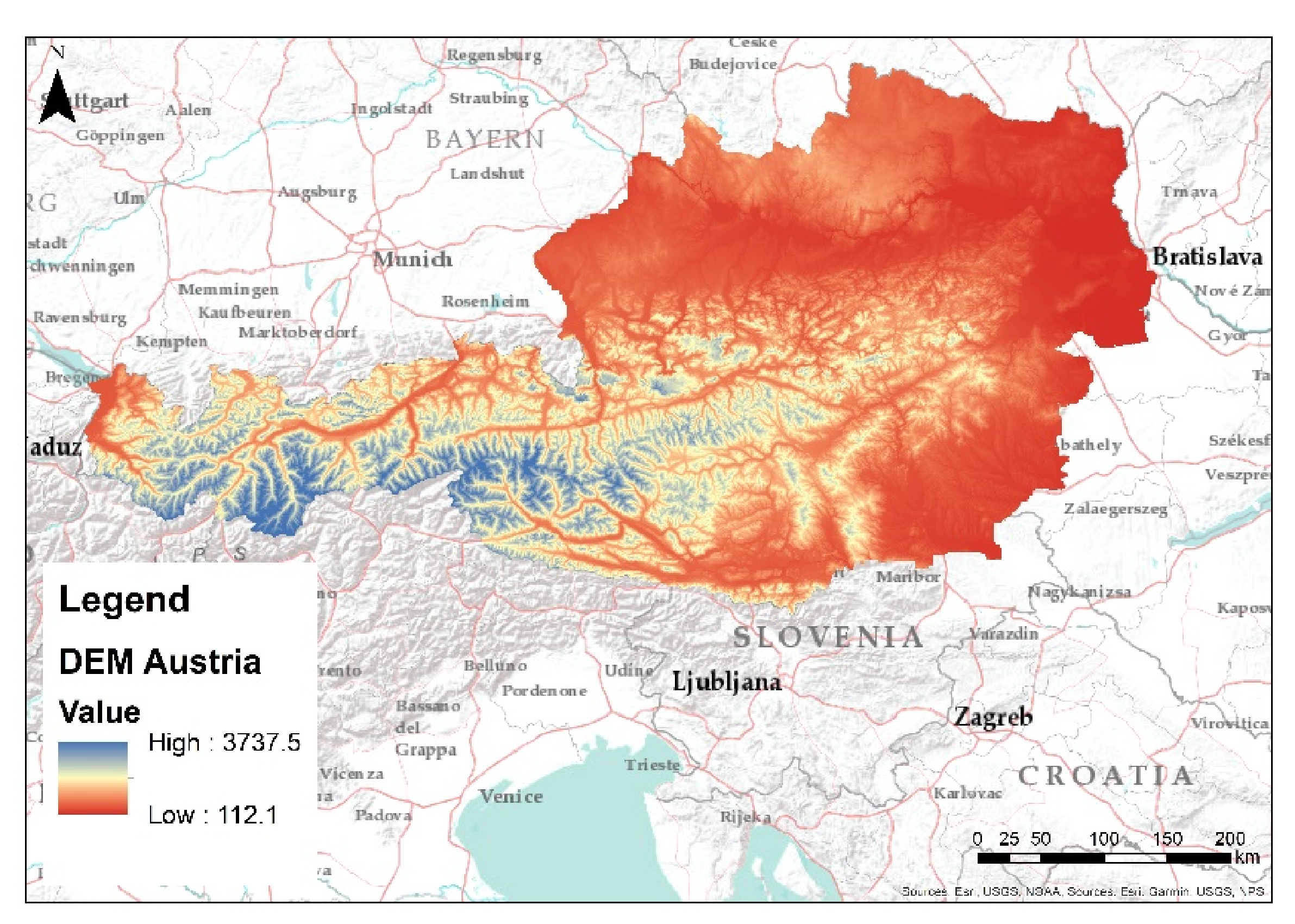
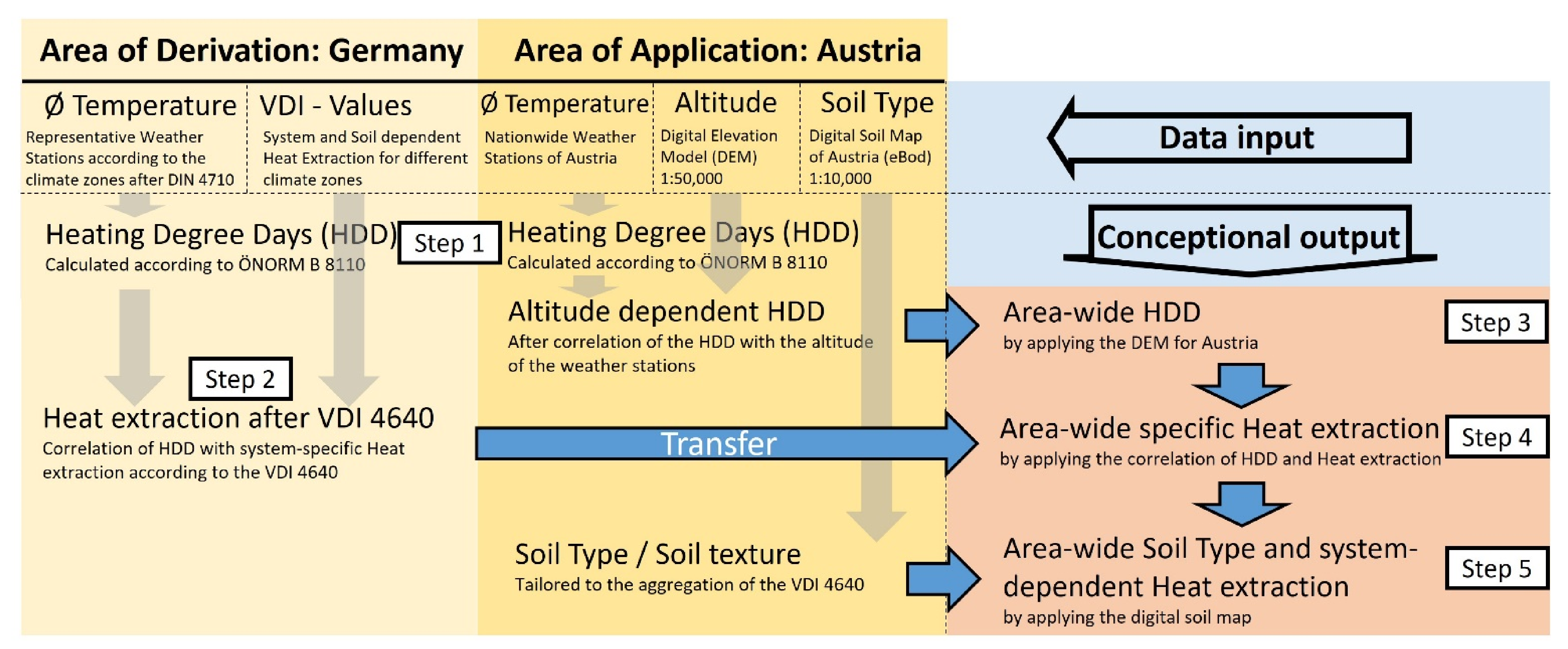

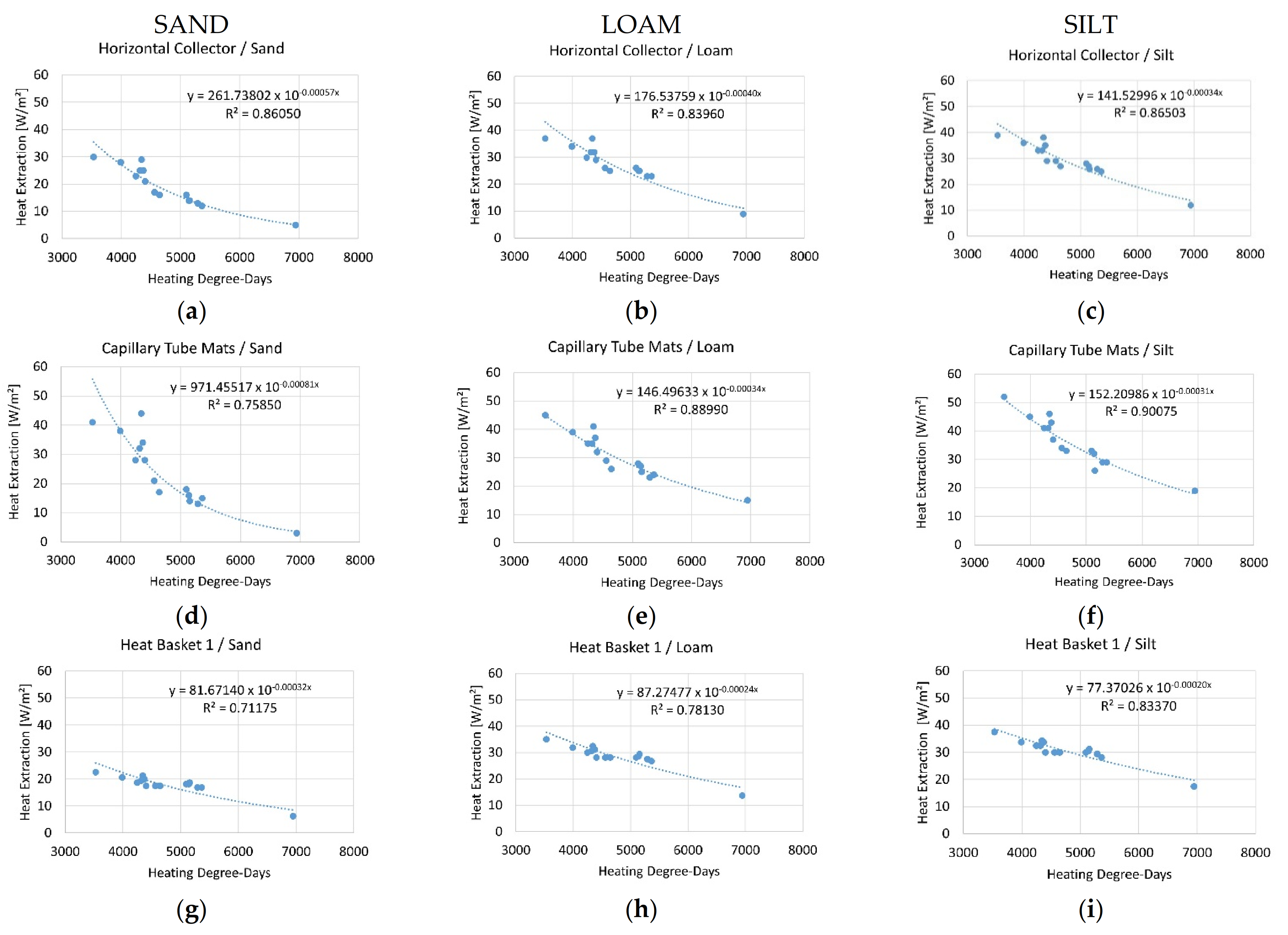
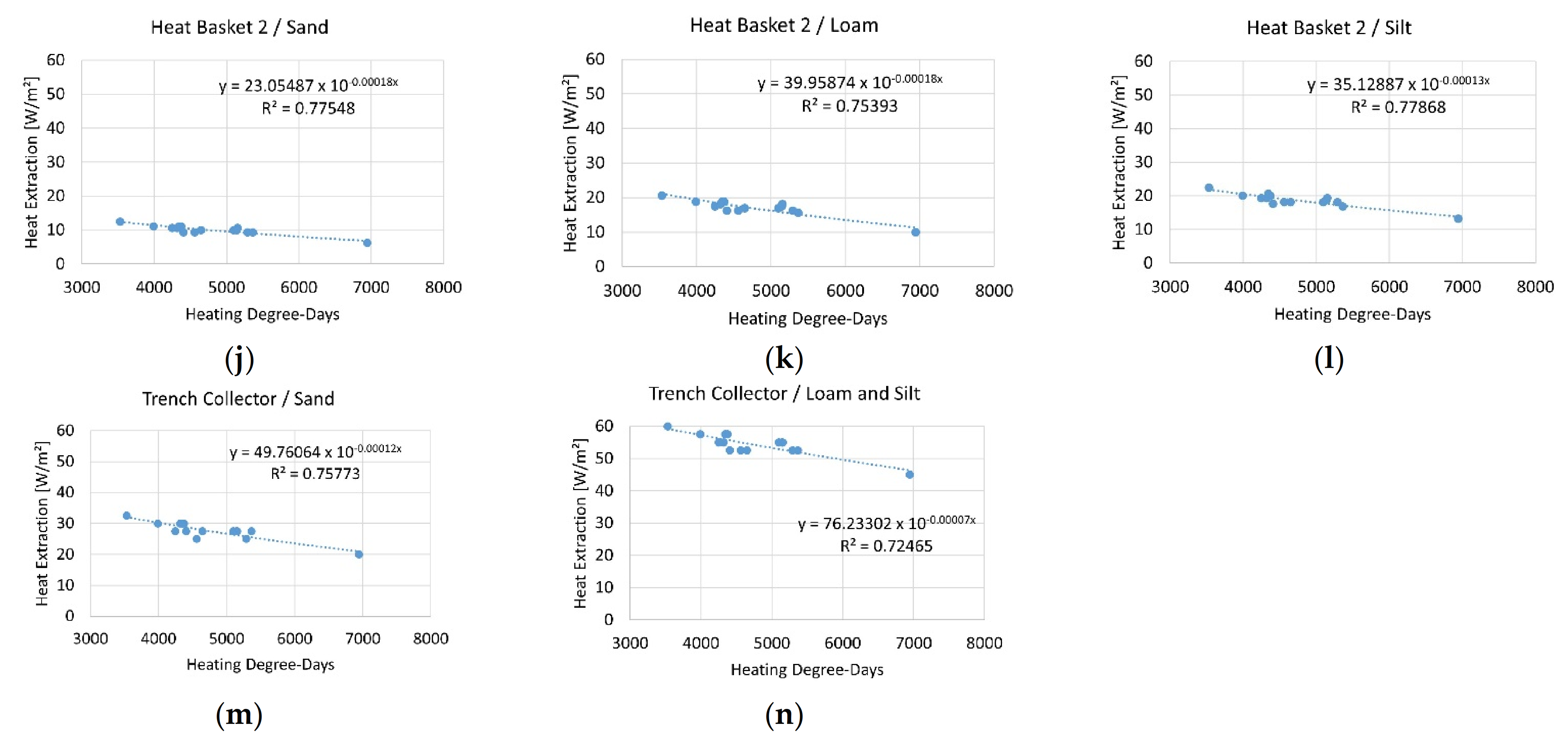


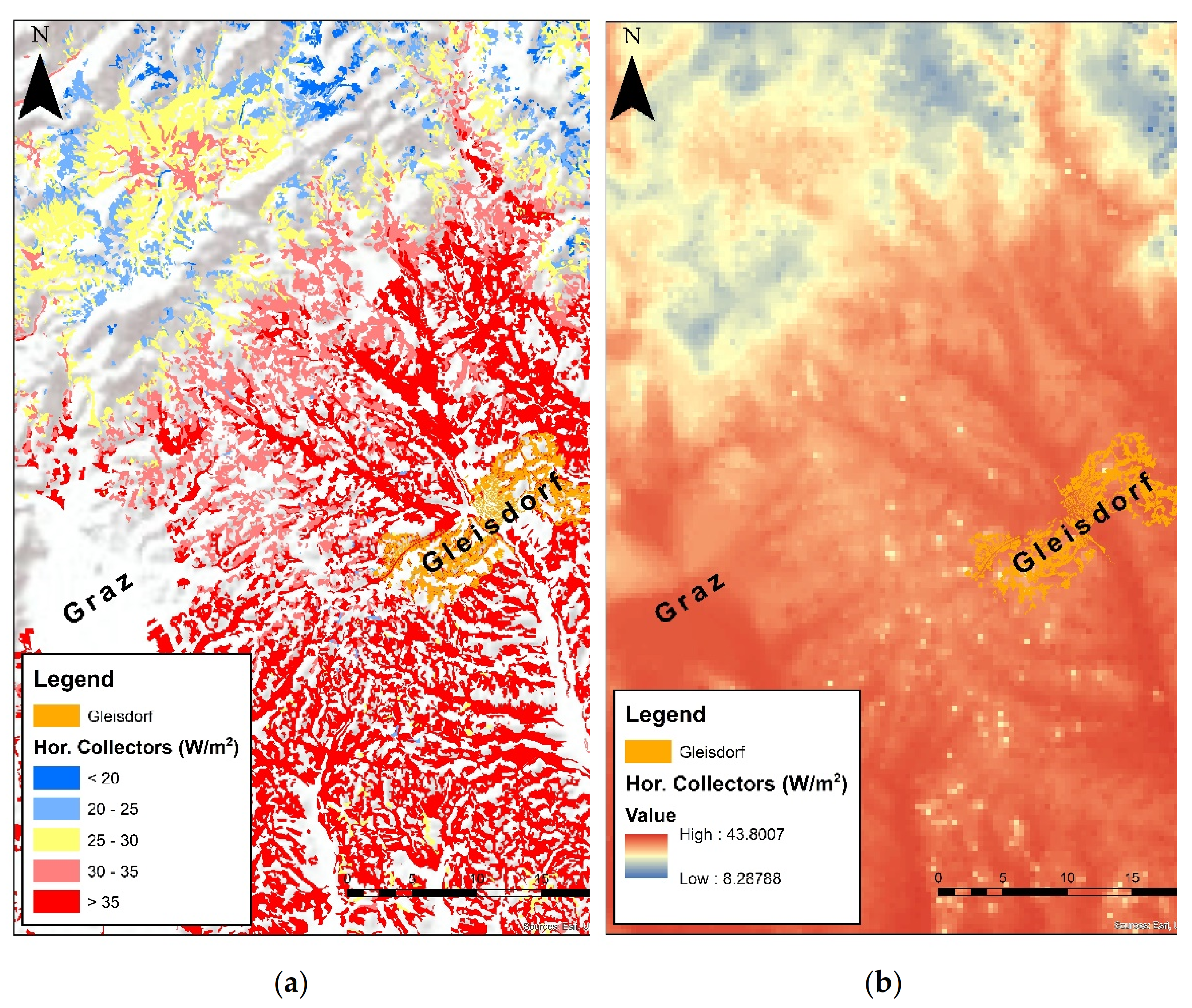
| Very Shallow Geothermal System | Soil Texture Group | Calculation Model for Heat Extraction (P) Based on HDD (x) | Coefficient of Determination |
|---|---|---|---|
| Horizontal Collector | Sand | P = 261.74 10−0.0005667956x [W/m²] | R² = 0.94 |
| Loam | P = 176.54 10−0.0003992871x [W/m²] | R² = 0.89 | |
| Silt | P = 141.53 10−0.0003357456x [W/m²] | R² = 0.90 | |
| Capillary Tube Mats | Sand | P = 971.46 10−0.0008099321x [W/m²] | R² = 0.92 |
| Loam | P = 146.50 10−0.0003352380x [W/m²] | R² = 0.91 | |
| Silt | P = 152.21 10−0.0003090645x [W/m²] | R² = 0.91 | |
| Heat Basket 1 | Sand | P = 81.67 10−0.0003242691x [W/m²] | R² = 0.76 |
| Loam | P = 87.27 10−0.0002375047x [W/m²] | R² = 0.81 | |
| Silt | P = 77.37 10−0.0001963163x [W/m²] | R² = 0.85 | |
| Heat Basket 2 | Sand | P = 23.05 10−0.0001750295x [W/m²] | R² = 0.80 |
| Loam | P = 39.96 10−0.0001807998x [W/m²] | R² = 0.79 | |
| Silt | P = 35.13 10−0.0001341375x [W/m²] | R² = 0.80 | |
| Trench Collector | Sand | P = 49.76 10−0.0001244829x [W/m²] | R² = 0.78 |
| Loam and Silt | P = 76.23 10−0.0000715544x [W/m²] | R² = 0.74 |
Publisher’s Note: MDPI stays neutral with regard to jurisdictional claims in published maps and institutional affiliations. |
© 2022 by the authors. Licensee MDPI, Basel, Switzerland. This article is an open access article distributed under the terms and conditions of the Creative Commons Attribution (CC BY) license (https://creativecommons.org/licenses/by/4.0/).
Share and Cite
Schwarz, H.; Jocic, N.; Bertermann, D. Development of a Calculation Concept for Mapping Specific Heat Extraction for Very Shallow Geothermal Systems. Sustainability 2022, 14, 4199. https://doi.org/10.3390/su14074199
Schwarz H, Jocic N, Bertermann D. Development of a Calculation Concept for Mapping Specific Heat Extraction for Very Shallow Geothermal Systems. Sustainability. 2022; 14(7):4199. https://doi.org/10.3390/su14074199
Chicago/Turabian StyleSchwarz, Hans, Nikola Jocic, and David Bertermann. 2022. "Development of a Calculation Concept for Mapping Specific Heat Extraction for Very Shallow Geothermal Systems" Sustainability 14, no. 7: 4199. https://doi.org/10.3390/su14074199
APA StyleSchwarz, H., Jocic, N., & Bertermann, D. (2022). Development of a Calculation Concept for Mapping Specific Heat Extraction for Very Shallow Geothermal Systems. Sustainability, 14(7), 4199. https://doi.org/10.3390/su14074199







